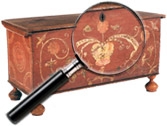The Classical Period, 1800 to 1840
Some may find the Classical Period of American furniture to be somewhat confusing as it overlaps that of the Federal Period. This confusion may be particularly acute among dealers and collectors of country American furniture, for while we do see many pieces of fine Federal furniture, we less frequently see examples of Classical furniture and, when we do, there is seldom anything country in its form or finish. However, if one were to take a piece of Federal furniture and a piece of Classical furniture from the same time frame and visually compare the two, the differences would be readily apparent.
Classical as defined by most dictionaries pertains to the ancient Greek, Roman and Egyptian styles or designs. This applies not only to furnishings, but to all art and literature. With the major excavations of the lost Roman cities of Herculaneum in 1738 and Pompeii in 1808, there began in all of Europe, England and even here in the United States, a renewed interest in the artifacts and designs of these ancient civilizations. Craftsmen began to incorporate aspects of these ancient designs into their modern creations, for the most part using current styles as the base, but adding touches that took the piece away from the pure form of Hepplewhite or Sheraton. Furniture with architecturally derived elements, scroll arms, lyre backs and ancient stretcher types began to appear in the market place. Lyre or columnar bases were applied to tables and marble was added to their tops. The ancient Greek curule stool became popular, as did furniture with brass animal claw feet and candle stands with Greek and Roman columns and gilt decoration.
These designs first appeared in France where a revolution had beheaded the King and the country was being governed first by Committee and then the Directory. In 1799 Napoleon, riding on a wave of military victories, overthrew the Directory and named himself Consul. Napoleon saw his rule as the reincarnation of the Roman Empire, hence the name Empire for the style of furniture popular during his reign.
Here in the United States while we were celebrating our independence with furnishings of elegance and grace adorned with stars, eagles and other Federal symbols, we also were venturing abroad as a world-class trading nation with sailing ships to be found in ports all around the globe. Returning captains and traders not only brought back goods made in all of these exotic ports but also ideas that could be applied to goods crafted in this country.
Though England still held a strong cultural influence over our new nation, an underlying animosity caused by both the revolution and the war of 1812 left open the way for fresh ideas from other lands, France being its principle beneficiary. We begin to see as early as 1800 to 1810 the emergence of certain aspects of this Classical design with New York cabinetmakers Duncan Phyfe and Charles-Honore Lannuier, a French immigrant, leading the way with their furniture. While there are solid indications of both Hepplewhite and Sheraton styles in their offerings, modifications were made to accommodate the “new” fashion of the ancients. Solid brass paw feet on their furniture, lyre backed chairs and saber legs all reflected the ancient forms of Greece, Rome and Egypt. The scroll arm found in many chairs of the period is definitely from the ancients. Couple that with the very ornate sofas in the style of ancient Grecian couches crafted in our major cities, curule stools and the pedestal-based marble-topped table and we have designs that are sufficiently unique as to form and origin as to warrant their own attribution.
The Classical design influence was felt throughout the nineteenth century as various “revival” styles began to make their appearance.
Reference note by p4A Contributing Editor Charles Wiebel.
